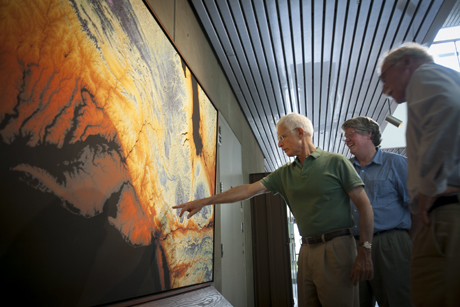Rotating art collection reflects science and art
By Kathy Hovis

When he looks at local artist Edward Heiple’s vibrantly colored pieces of art hanging in the atrium of Corson-Mudd Hall, graduate student Geoffrey Broadhead said he sees cellular components and structures. It’s appropriate that he does, since Corson-Mudd houses the Departments of Neurobiology and Behavior and of Ecology and Evolutionary Biology.
Students like Broadhead, as well as faculty, staff and many people who use the atrium for parties and receptions, are enjoying Heiple’s pieces, and will see up to 10 fresh pieces of artwork each year from local artist Jay Hart, as the departments starts a rotating art agreement with Hart for the next three years.
The departments hosted a reception May 22 to unveil the new artwork and allow the artists to talk about their pieces.
“My background growing up on a farm, working with animals and biology definitely surfaces in the pieces I do,” explained Heiple.
Heiple and Hart, whose work is somewhat realistic and features broad scale map and image graphics from a comprehensive global sample, say their art is similar in that both use the idea of nested scales, which make the pieces different from afar than up close.
To complete his work, Hart uses his curiosity and geographic sense to find intriguing places with interesting textures and shapes, in some cases drawn also by a story. He then chooses colors to highlight terrain and patterns in the land.
“My work presents the obvious in less obvious ways,” said Hart. “I want people to work a little bit before they recognize the place.”
One of the pieces in the atrium, for example, depicts the local region but it is not immediately recognizable because north is oriented toward the side rather than the top.
Heiple creates his art by cutting acrylic into puzzle-like pieces and then painting them from the back with acrylic gel. The front finished side of the piece is covered during the painting process, so Heiple doesn’t really see the finished work until he has added all the layers.
Pieces from the two artists were originally hung in the atrium in 2008, thanks to the efforts of Ron Hoy, professor of biology. Ron Harris-Warrick, professor of neurobiology and behavior, has also been a key player in the new gallery.
Hoy and Harris-Warrick said the artists’ works tie science and art together in so many ways – their multiple scales, their cellular-like structures and their grounding in geography and geology.
“For those of us who work in the building all of the time, now we have this really stunning open space,” Harris-Warrick said.
The atrium also includes a collection of bird specimens from the Cornell Lab of Ornithology, photographs from famed Cornell insect expert Professor Thomas Eisner and a selection of glass invertebrates from the Cornell Blaschka Collection.
Kathy Hovis is a writer for the College of Arts and Sciences.
Media Contact
Get Cornell news delivered right to your inbox.
Subscribe